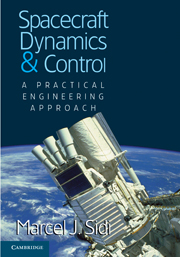Book contents
- Frontmatter
- Dedication
- Contents
- Preface
- Acknowledgments
- Chapter 1 Introduction
- Chapter 2 Orbit Dynamics
- Chapter 3 Orbital Maneuvers
- Chapter 4 Attitude Dynamics and Kinematics
- Chapter 5 Gravity Gradient Stabilization
- Chapter 6 Single- and Dual-Spin Stabilization
- Chapter 7 Attitude Maneuvers in Space
- Chapter 8 Momentum-Biased Attitude Stabilization
- Chapter 9 Reaction Thruster Attitude Control
- Chapter 10 Structural Dynamics and Liquid Sloshing
- Appendix A Attitude Transformations in Space
- Appendix B Attitude Determination Hardware
- Appendix C Orbit and Attitude Control Hardware
- Index
- References
Chapter 6 - Single- and Dual-Spin Stabilization
Published online by Cambridge University Press: 18 December 2014
- Frontmatter
- Dedication
- Contents
- Preface
- Acknowledgments
- Chapter 1 Introduction
- Chapter 2 Orbit Dynamics
- Chapter 3 Orbital Maneuvers
- Chapter 4 Attitude Dynamics and Kinematics
- Chapter 5 Gravity Gradient Stabilization
- Chapter 6 Single- and Dual-Spin Stabilization
- Chapter 7 Attitude Maneuvers in Space
- Chapter 8 Momentum-Biased Attitude Stabilization
- Chapter 9 Reaction Thruster Attitude Control
- Chapter 10 Structural Dynamics and Liquid Sloshing
- Appendix A Attitude Transformations in Space
- Appendix B Attitude Determination Hardware
- Appendix C Orbit and Attitude Control Hardware
- Index
- References
Summary
Introduction
As discussed in Chapter 4, a body spinning about its major or minor axis will keep the direction of its spinning axis fixed with respect to the inertial space. This direction, according to Euler's moment equations of angular motion, will change only if external moments are applied about its center of mass and perpendicularly to the spin axis.
Almost all spacecraft employ the spin effect during part or all of their lifetime in space. Many satellites are spin-stabilized during the orbital maneuvering stage (e.g., in the transfer from the initial orbit to the final mission orbit) so that parasitic torque disturbances, produced by the high thrust of the apogee boost motor, do not appreciably change the nominal direction of the additional vector velocity ΔV imparted to the satellite. The dynamic attributes of spinning bodies are used also to stabilize satellites' attitude within the final mission orbit. Spin stabilization was used in the first communications satellites in the early sixties, and in a large number of modern satellites (see e.g. Fagg and MacLauchlan 1981, Fox 1986).
Single-spin attitude stabilization is a very simple concept from the perspective of attitude control, but it has some crucial drawbacks with respect to communication efficiency. Dual-spin three-axis attitude stabilization, which is an extension of the single-spin stabilization principle, alleviates the communication deficiency. We shall find conditions under which passive nutation damping is feasible for dual-spin stabilized spacecraft.
Attitude Spin Stabilization during the ΔV Stage
As already mentioned, a common way to stabilize the attitude of a s/c during orbital maneuvering (the ΔV stage) is to spin-stabilize the axis along which the propulsion thruster is aligned. Unfortunately, the direction of the applied thrust does not pass exactly through the center of mass (cm) of the satellite, and a parasitic torque results that tends to change the nominal attitude of the spin axis. Since the thruster is fixed to the satellite's body, change of the attitude of the satellite will induce an error in the application of ΔV, with the result that the required new orbit parameters will not be achieved (see Section 3.4.3).
Information
- Type
- Chapter
- Information
- Spacecraft Dynamics and ControlA Practical Engineering Approach, pp. 132 - 151Publisher: Cambridge University PressPrint publication year: 1997
